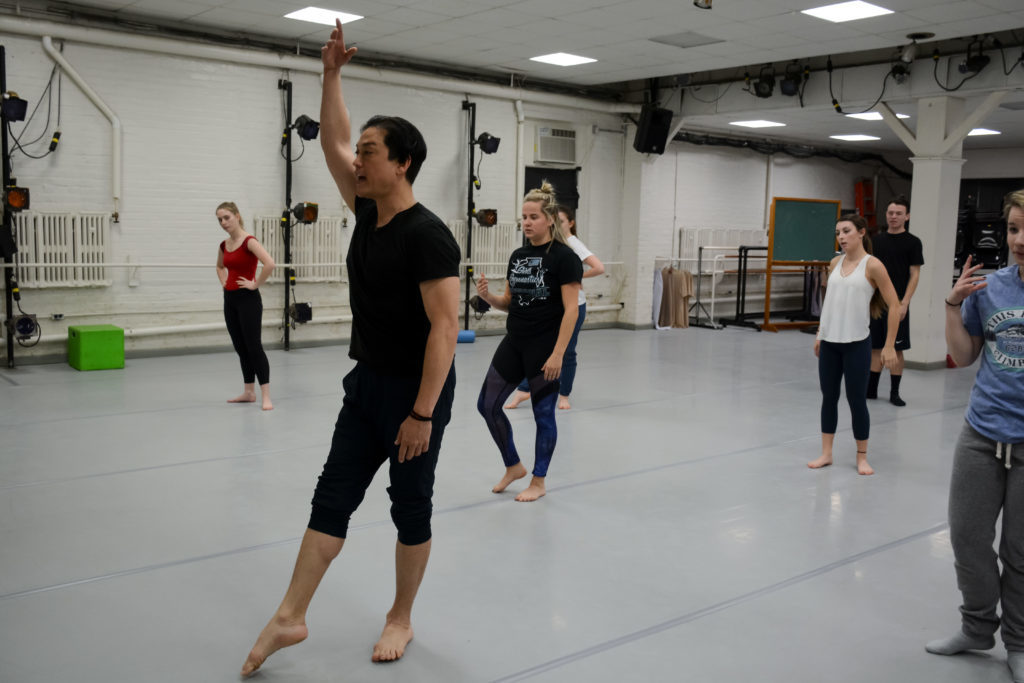Updated: Dec. 7, 2017 at 2:45 p.m.
Two trios of dancers solemnly move around the room to surround a lone woman as the first line of Sylvia Plath’s poem reads in the background: “I am vertical, but I would rather be horizontal.”
One of the dancers is Dana Tai Soon Burgess, a professor of dance, who made history when he was named the Smithsonian’s first choreographer-in-residence last year. Burgess will perform his 30-minute choreographed piece with his dance company Thursday and Sunday at the Smithsonian’s National Portrait Gallery as his fourth project in the new position.
“I Am Vertical” will show as part of the gallery’s year-long exhibit “One Life: Sylvia Plath” that is on display until May 20. The exhibition showcases the poet’s life through objects and manuscripts from the Plath Archives and as a complement to the exhibit, Burgess’ choreography explores the dysfunction in Plath’s marriage that led to her suicide in 1963.
The performance is only the start of Burgess’ new relationship with the National Portrait Gallery. He will hold a position as the museum’s choreographer-in-residence for the next three years where he will create dance routines that explore the same subject matter as museum exhibits.
“It’s a great match. I’m very interested about movement, using it as a form of communication to tell stories in a very poetic and artistic way,” Burgess said.
Burgess’ first project was based on the National Portrait Gallery’s Sylvia Plath exhibit but he said he has two other shows currently in the works. The first will focus on American laborers and another will focus on the concept of the silhouette in portraiture.
The new position seeks to connect visual arts with performing arts to tell history in full. Burgess said he sees the opportunity as a unique way to unite dance with the visual arts. Because of his upbringing surrounded by artists, Burgess said he can easily work with visual artists to further tell their story through dance.
“There was this perfect parallel between the way I look at dance and create dance, and the subject matters I’m interested in and what the subject matter of their exhibitions are,” Burgess said. “The other thing is because my parents were visual artists, I think I often look at the stage as a canvas and so I’m very attuned to what the creative process is.”
As choreographer-in-residence, Burgess works with historians and curators to learn more about the exhibits they show and uses that as his inspiration. Burgess said he has enjoyed working with the Smithsonian because they understand the importance of his craft and Kim Sajet, the National Portrait Gallery’s director, is particularly “progressive” in adopting this idea.
“The Smithsonian understands the process of making and presenting a dance, of what dance needs to communicate to a larger broader public,” Burgess said.
As a storyteller, Burgess finds his inspiration in American history making his position the perfect combination of his interests.
“I’m very interested in capturing, through dance, stories that are part of our American tapestry,” he said. “If you think about the National Portrait Gallery, it’s a repository of America’s portraiture in terms of a context about what has gone on in America.”
As the founder of the Dana Tai Soon Burgess Dance Company, which is in its 25th year, Burgess is recognized as D.C.’s main modern dance company with performances around the District.
In addition to his new work with the Smithsonian museums, Burgess’ company has performed at the Kennedy Center and toured for the State Department with performances in dozens of countries around the world like Ecuador, Israel and Mongolia.
As the troupe performs in the District and abroad, Burgess sees dance as a powerful way to communicate with audiences, foreign or otherwise.
“The one thing that is consistent about dance is being able to read people’s movement and body language because I think that’s a universal form of communication.” Burgess said. “I try to look for that universal component so no matter where you’re from or what your background is, you’ll feel empathetic to the characters.”




